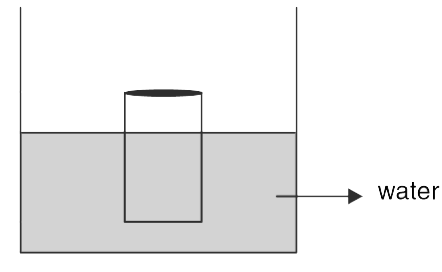Solve the prievious problem if the lead piece is fastened on the top surface of the block and the block is to float with its upper surface just dipping into water.
mw=200g,ρw=0.8gm,<br>rho_(pb)=11.3gm/cc<br>Again Mg=w<br>rarr (m_w+m_(pb))g=V_wxxrhoxxg<br>[ρ=densityofwater]<br>rarr 200+m_(pb)=200/0.8x1<br>rarrm_(pb)=250-200=50gm
Topper's Solved these Questions
Similar Questions
A cubical block of wood weighing 200g has a lead piece fastened underneath. Find the mass of the lead pieces which will just allow the block to float in water. Specific gravity of wood is 0.8 and that of lead is 11.3.
(b) Solve the previous problem if the lead piece is fastened on the top surface of the block and the block is to float with its upper surface just dipping into water.
View SolutionA wooden block of cross sectional area A (in shape of a rectangle) has height h. It is held such that its lower surface touches the water surface in a wide and deep tank. The block is released in this positon. It oscillates for some time and then settles into its equilibrium positon. in equilibrium the block floats with its upper face just on the water surface. Calculate the amount of heat generated in the process assuming that the loss in gravitational potential energy of the system coprising of water and the block gets converted into heat. Density of water is ρ.

View Solution
Knowledge Check
Larva of 'Culex' floats on surface of water with its head
ADirected upwardsBDirected downwardsCParallel to surfaceDAttached to surface of water.In the previous problem , the bullet penetrates the block and emerges with speed v0.If the block travels 2.5m on the rough surface , the value of v0 is
A155m/sB205m/sC310m/sD100m/sA rectangular wooden block 5cm×10cm×10cm in size is kept on a horizontal surface with its face of largest area on the surface. A minimum force of 1.5 N applied parallel to the surface sets the block in sliding motion along the surface. If the block is now kept with its face of smaller area in contact with the surface, the minimum force applied parallel to the surface, to set the block in motion, is
Agreater than 1.5 NBless than 1.5 NCequal to 1.5 NDmay be greater or less than 1.5 N
In the above problem calculate the downward force on the frame if the fame placed vertically with its longest aide just touching the surface of water.
View SolutionA cyclindrical ice block is floating in water 10% of its total volume is outside water. Kerosene oil (relative density=0.8) is poured slowly on top of water in the container. Assume that the oil does not mix with water. Height of the ice cylinder is H.

(a) As kerosene is poured, how does the volume of ice block above the water level change?
(b) What is the thickness of kerosene layer above the water when 20% of the volume of the ice block is above the water surface?
(c) Find the ratio of voume of ice block is kerosene to its volume in water after the kerosene layer rises above the top surface of ice and the block gets completely submerged. Neglect any melting of ice.
View SolutionFind the density of a block of wood that floats in water with 0.1 of its volume above water
View SolutionFind the density of a block of wood that floats in water with 0.1 of its volume above water
View SolutionA rectangular wooden block 5×cm10cm×10cm in size is kept on a horizontal surface with its face of largeest area on the surface. A minimum force of 1.5N applied parallel to the surface. Sets the block in sliding motion along the surface. If the block is now kept with its face of smaller area in contant with the surface, the minimum force applied parallel to the surface, to set the block in motion, is.

View Solution
